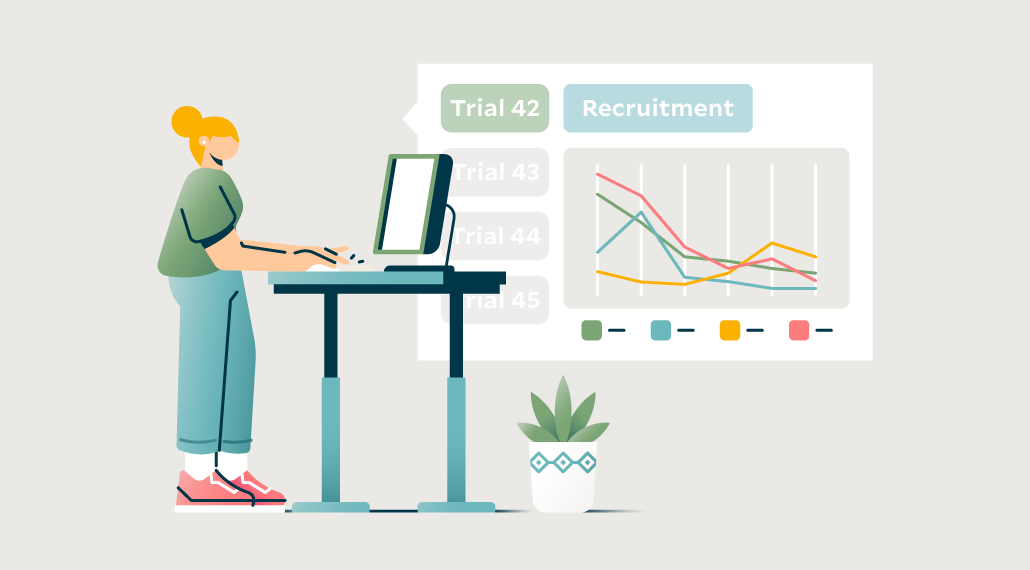December 12th, 2022
Why Neurology Clinical Trial Protocols are So Complex–and How to Support Sites with StudyTeam
By OneStudyTeam

According to StudyTeam reports, neurology has one of the lower enrollment conversion rates relative to other therapeutic areas. As an example: For all of the neurology patient candidates who connect with a site, a lower number of those candidates actually enroll in the trial, compared with patients connecting with and enrolling in pulmonology trials. Protocol complexities can be a major contributing factor to lower enrollment rates.
The good news: Expert clinical trial design within a centralized platform for managing recruitment and enrollment like StudyTeam can ease the burden of complex protocols on site staff. “Our Trial Design team configures StudyTeam to best suit the complexities of a particular protocol,” said Laura Englund, former Trial Design Lead at OneStudyTeam.
Using StudyTeam, customized per specific neurology protocols, site staff can work to move eligible patients through the enrollment process at a faster pace to support enrollment conversion rates. Here are a few reasons why neurology trial protocols are so complex–and how sponsors can support sites when they choose StudyTeam.
Extensive I/E criteria
To ensure studies are safe and relevant for neurology patients, I/E criteria can be difficult to meet. For example, a protocol for a migraine study might include multiple pages of highly specific exclusion criteria. The criteria could exclude patients based on long lists of prior preventative therapies, history of other significant disorders or diseases, and use of certain medications up to 3 months prior to initial screening.
Unsurprisingly then, screen failure rates are high across central nervous system (CNS) and neurology clinical trials. From 2012 to 2019, those screen failure rates jumped from 29.5% to 57%. But with the right patient enrollment management platform, patients who fail screening for one neuro trial can be easily considered for another neuro trial.
StudyTeam serves as one digital platform that sites can use to securely store patient information across every clinical trial they are working on. Based on I/E criteria for a specific protocol, OneStudyTeam’s Trial Design experts create custom pre-screening and screening logs that site staff can easily update during patient visits.
“A lot of the sites we work with are managing patient candidates across multiple neurology trials,” said Jen Hays, Senior Clinical Trial Lead at OneStudyTeam. “So when they input patient information, including research indications and diagnoses, they are better able to match the right patients to the right trials. A patient who fails to meet all of the criteria for one trial, for example, may meet all of the criteria for another trial at the same site. Site staff can filter that criteria right in StudyTeam. That means the pre-screening and screening work they do for one trial could help them enroll patients for another trial.”
Complicated or lengthy screening tests
Many protocols may require neuroimaging during the screening process to determine aspects of brain structure and function. Even if neuroimaging is not necessary, site staff may be managing long lists of other screening tests, from hematology labs to electrocardiograms (ECGs).
To simplify patient management during screening visits, Visit Checklists can be added within StudyTeam to ensure all tests are completed in a timely manner.
“Our Trial Design team builds Visit Checklists for certain sites based on the protocol and trial need,” Englund said. “We will take from the protocol and the schedule of activities every single procedure that needs to happen at every visit, and we will put that in StudyTeam. This way, site staff can check off all of the tasks during a visit that are specific to that visit.”
The Visit Checklist ensures site staff are not missing any steps, giving them the peace of mind that the visit is complete and they can move the patient farther along in the enrollment process.
High number of visits per patient
Patients receiving an investigational product may be required to have monthly scheduled visits in addition to initial pre-screening calls and screening visits. To avoid protocol deviations, our Trial Design experts can program the Visit Schedule in StudyTeam to ensure visits are scheduled in the precise windows.
“It is easy to put in a tolerance within our system for almost every visit possible,” Englund said. “The Visit Schedule very clearly shows the target date for a specific visit, factoring in tolerances so the site staff see the whole window of possibilities. We take that responsibility off the site of figuring out those calculations, which can be extremely complex. So staff are able to quickly and confidently schedule patient visits in StudyTeam per protocol needs.”
Once the enrollment process is complete, sites continue to benefit from the feature.
“We set up the Visit Schedule to include every visit in the study, treatment and follow-up visits included,” Englund said. “When needed, we build the tool into even more parts of the study, such as into an imaging schedule. So sites can continue to use StudyTeam after pre-screening is closed.”
“A tool like this also benefits the sponsor by preventing protocol deviations, which can affect trial timelines,” Hays said. “And when site staff are using the Visit Schedule, this means they are in the StudyTeam platform regularly, engaging with the system and increasing the opportunity to input other patient data that is important to the sponsor.”
Build StudyTeam into your trial design
"Our dedicated Trial Design team, many who have directly worked at clinical trial sites or with sponsor companies, are experts at reading each protocol," Hays said. "They then build out the StudyTeam platform for each site to best align with the sponsor protocol and include many additional features to make workflows easier for sites."
Not only does StudyTeam provide easy-to-use visit management, pre-screening, and screening features for sites, but it offers sponsors greater visibility into enrollment performance and opportunities for intervention, based on site data input.
Related Posts

How Does a Trial Manager in Greece Improve Clinical Trial Operations with StudyTeam®?
Dimitris Tziogas, local trial manager at a biotechnology company in ...
Read More
How to Address Key Clinical Trial Challenges, According to Clinresco Centres in South Africa
There’s no single solution to overcoming a research site’s specific ...
Read More
3 Clinical Trial Billing Challenges Research Sites Solve with StudyTeam
Challenge 1: Complicated coverage analysis Challenge 2: Tedious budgeting ...
Read More
.png?width=64&name=OST%20Transparent%20(1).png)